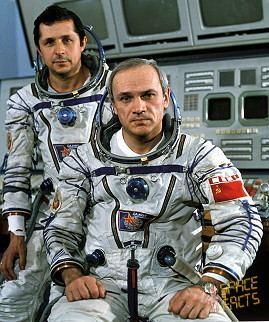COSPAR ID 1985-043A Period 1.5 hours Launch date 6 June 1985 Landing date 26 September 1985 | Orbits completed 2,645 Manufacturer NPO Energia Dates 6 Jun 1985 – 26 Sep 1985 | |
 | ||
Mission duration 112 days, 3 hours, 12 minutes, 6 seconds Launch mass 6,850 kilograms (15,100 lb) | ||
Soyuz T-13 was a Soyuz mission, a human spaceflight mission transporting personnel to the Russian space station Salyut 7. The eighth expedition to the orbital station, the mission launched from Baikonur Cosmodrome, atop a Soyuz-U2 carrier rocket, at 06:39:52 UTC on 1985-06-06. It is of note because it marked the first time a spacecraft had docked with a 'dead' space station, and the first time such a station had been returned to operational status following repairs.
Contents
Mission highlights
Soyuz T-13 was the 8th expedition to Salyut 7.
Vladimir Dzhanibekov could have had no notion that he would so soon visit Salyut 7 after his Soyuz T-12 flight, and what more on the first Soyuz flight to dock manually with an inert space station, as Salyut 7 had been crippled by a solar array problem. For this purpose modifications were made to the Soyuz spacecraft to include control levers for proximity operations. Viktor Savinykh's and Vladimir Dzhanibekov's mission was successful and they were able to salvage the Salyut 7 station. Savinykh remained aloft for 169 days, returning to Earth in Soyuz T-14; Dzhanibekov returned to Earth in Soyuz T-13 with Grechko after spending 110 days on Salyut 7. Before deorbiting, Soyuz T-13 spent about 30 h conducting rendezvous and docking tests.
Salvaging Salyut 7
The effort to salvage Salyut 7 was in the words of author David S. F. Portree "one of the most impressive feats of in-space repairs in history". As the crew approached the inert station, they saw that its solar arrays were pointing randomly as it rolled slowly about its long axis. They used a handheld laser rangefinder to judge their distance, and conducted a fly-around inspection to be certain the exterior was intact. Dzhanibekov noted that the thermal blankets on the transfer compartment had turned a dull gray from prolonged exposure to sunlight.
Dzhanibekov piloted his ship to intercept the forward port of Salyut 7, matched the station's rotation and achieved soft dock with the station. Upon achieving hard dock—the only time a spacecraft has docked with an inert space station—the crew confirmed through the electrical connectors in the docking collars that the Salyut 7 electrical system was dead. They carefully sampled the air in the station before opening the hatch. The station air was very cold, but breathable. Frost covered the walls and apparatus. The cosmonauts wore winter garb, including fur-lined hats, as they entered the station.
The first order of business was to restore electric power. Two of the eight batteries were destroyed, the rest fully discharged. Dzhanibekov determined that a sensor in the solar array pointing system had failed, preventing the batteries from recharging. A telemetry radio problem prevented the TsUP from detecting the problem. Salyut 7 had quickly run down its batteries, shutting down all its systems and accounting for the break in radio contact. The cosmonauts set about recharging the batteries and used Soyuz T-13 to turn the station in order to point its solar arrays to the sun.
On June 10 they turned on the air heaters. The cosmonauts relied on the Soyuz T-13 air regeneration system until they could get the Salyut 7 system back in order. On June 13 the attitude control system was successfully reactivated. This was cause for jubilation, as it meant Kosmos 1669 (a Progress supply spacecraft) bearing replacement parts could dock with Salyut 7. The station’s water tanks thawed by the end of June – freezing had destroyed the water heater, so the cosmonauts used a powerful television light to heat fluids. Wall heaters were turned on only after all the frost had evaporated, in order to prevent water from entering equipment. Normal atmospheric humidity was achieved only at the end of July, nearly two months after docking.
